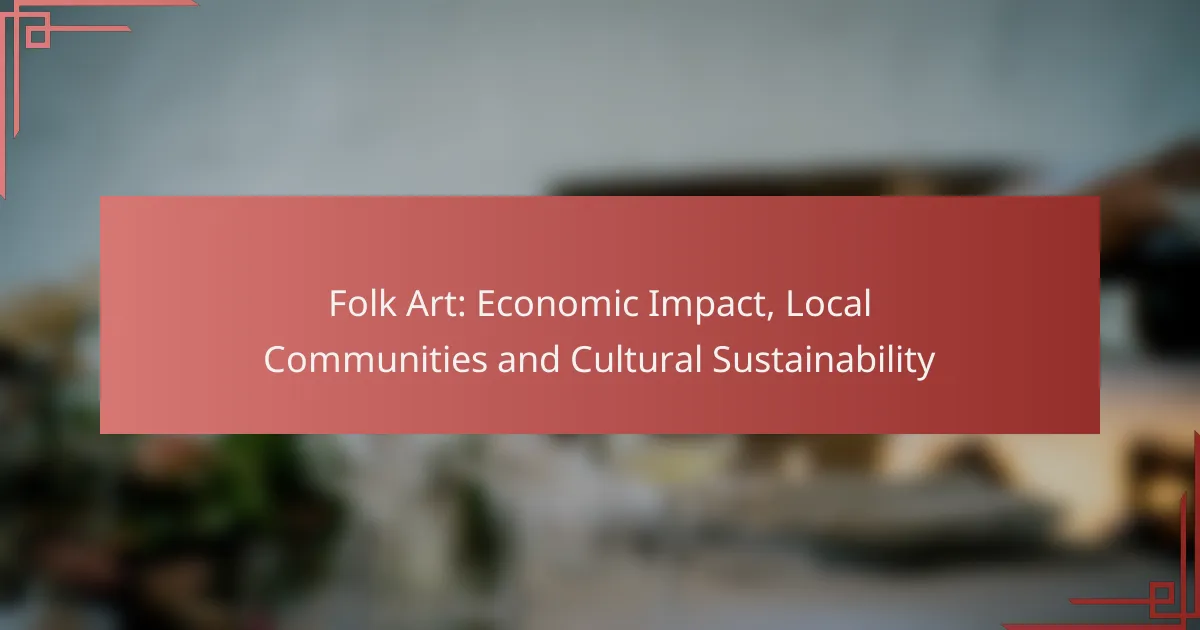Folk art serves as a powerful medium for cultural expression and community engagement, reflecting the values and aspirations of marginalized groups. By encapsulating local stories and experiences, it fosters a sense of belonging and continuity, while also influencing social movements and advocacy efforts. Through initiatives like workshops and public art events, communities can collaborate and celebrate their unique heritage, strengthening their ties in the process.
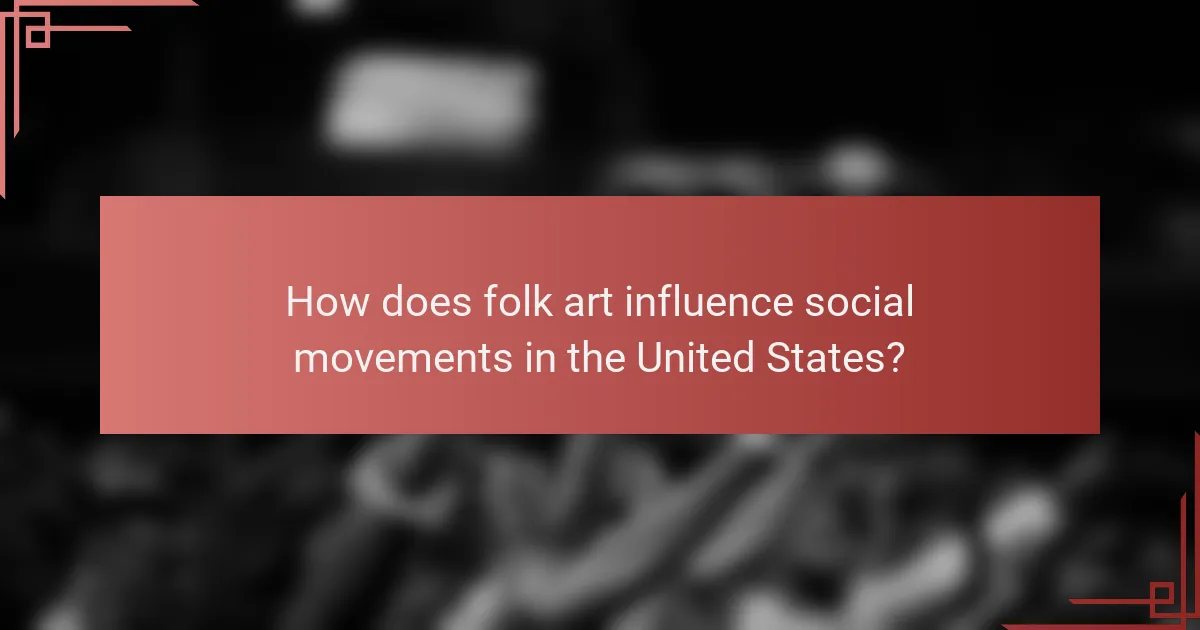
How does folk art influence social movements in the United States?
Folk art plays a significant role in influencing social movements in the United States by serving as a medium for cultural expression and community engagement. It reflects the values, struggles, and aspirations of marginalized groups, often becoming a powerful tool for advocacy and change.
Historical context of folk art in activism
The roots of folk art in activism can be traced back to various social movements throughout American history, including labor rights, civil rights, and anti-war protests. Artists have historically used folk art to communicate messages of resistance and solidarity, often drawing from local traditions and cultural narratives.
During the Great Depression, for example, folk artists created works that depicted the struggles of everyday people, highlighting issues such as poverty and unemployment. This tradition continued into the civil rights era, where art became a means of expressing the fight for equality and justice.
Case studies of folk art in civil rights movements
One notable case study is the use of murals in the Chicano civil rights movement of the 1960s and 1970s. Artists like Judy Baca and Carlos Almaraz created large-scale murals that depicted the history and struggles of the Mexican-American community, fostering a sense of identity and pride.
Similarly, during the civil rights movement, artists such as Faith Ringgold used quilts as a medium to tell stories of African American experiences, blending traditional craft with social commentary. These artworks not only raised awareness but also mobilized communities around shared goals.
Impact on community identity and solidarity
Folk art significantly impacts community identity by fostering a sense of belonging and shared purpose among individuals. Through collective creation and appreciation of folk art, communities can reinforce their cultural heritage and values, which is crucial for social cohesion.
Moreover, folk art initiatives often bring together diverse groups, promoting dialogue and understanding. For instance, community art projects can unite different generations and backgrounds, creating a platform for collaboration and mutual support in addressing local issues.
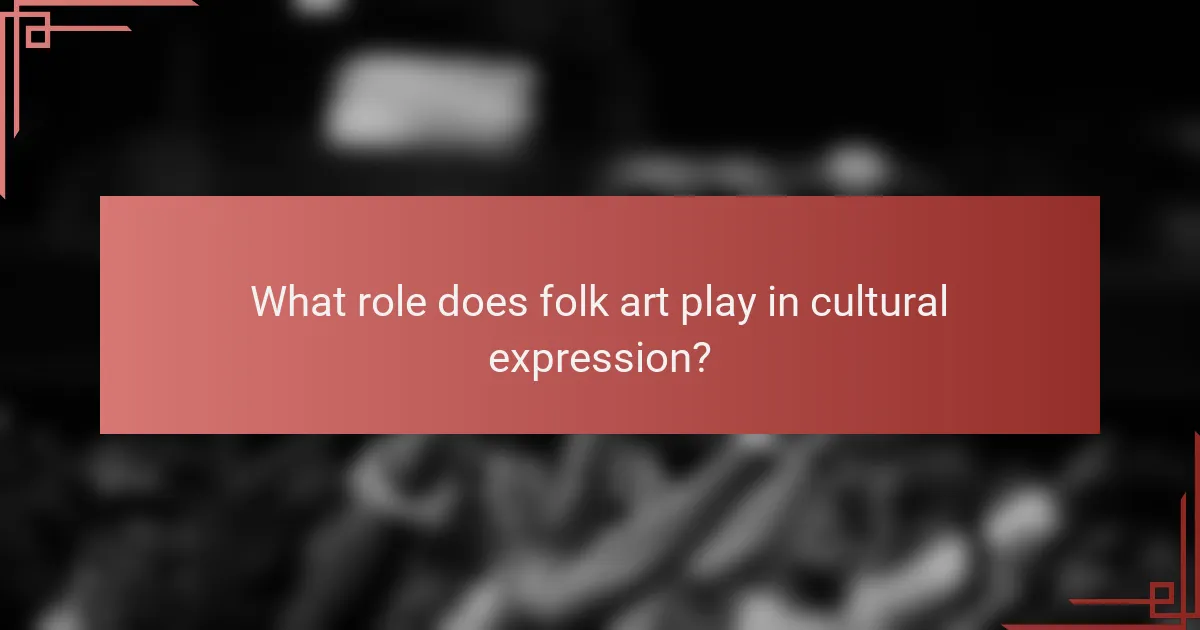
What role does folk art play in cultural expression?
Folk art serves as a vital medium for cultural expression, reflecting the values, traditions, and identities of communities. It encapsulates local stories and experiences, fostering a sense of belonging and continuity among people.
Forms of folk art as cultural narratives
Folk art manifests in various forms, including textiles, pottery, music, and dance, each telling unique cultural narratives. These art forms often incorporate symbols and motifs that represent local history, beliefs, and social issues, making them powerful tools for storytelling.
For instance, traditional weaving techniques can convey ancestral knowledge and community values, while folk songs may address social justice themes or historical events. This narrative quality helps preserve cultural heritage and educate future generations.
Examples of folk art in contemporary culture
Contemporary culture showcases folk art through festivals, community projects, and public installations. Events like local craft fairs and cultural festivals often feature artisans who create and sell folk art, allowing for direct engagement with the community.
Street art and murals can also be considered modern expressions of folk art, as they often reflect local issues and cultural identity. For example, murals in urban areas may depict historical figures or social movements, bridging the gap between traditional and contemporary forms of expression.
Influence of folk art on mainstream art
Folk art significantly influences mainstream art by introducing diverse perspectives and techniques. Many contemporary artists draw inspiration from folk traditions, incorporating elements such as patterns, colors, and storytelling into their work.
Art movements like folk art revival and outsider art highlight the importance of these influences, encouraging a broader appreciation for cultural diversity. Galleries and museums increasingly feature folk art alongside contemporary pieces, showcasing its relevance and impact on the art world.

How can communities engage with folk art?
Communities can engage with folk art through various initiatives that foster creativity, collaboration, and cultural expression. By organizing workshops, collaborating with local artists, and hosting public art events, communities can strengthen their ties and celebrate their unique heritage.
Community workshops and art programs
Community workshops and art programs provide hands-on opportunities for individuals to learn and create folk art. These programs can range from pottery and weaving to painting and storytelling, often led by experienced artisans. They not only enhance skills but also encourage cultural exchange and community bonding.
To maximize participation, consider offering workshops at different times and locations, ensuring accessibility for all community members. Collaborating with local schools or community centers can also help reach a broader audience.
Collaborations with local artists
Collaborating with local artists is essential for enriching folk art initiatives. Artists can bring their unique perspectives and techniques, which can inspire community members and elevate the quality of the artwork produced. These partnerships can take the form of mentorships, joint projects, or artist-in-residence programs.
When seeking collaborations, prioritize artists who have a strong connection to the community and its cultural heritage. This ensures that the art reflects local values and traditions, fostering a deeper sense of pride and ownership among participants.
Public art installations and festivals
Public art installations and festivals serve as vibrant platforms for showcasing folk art and engaging the wider community. These events can include murals, sculptures, and interactive installations that invite participation and dialogue. Festivals can feature performances, workshops, and exhibitions, creating a festive atmosphere that celebrates local culture.
To organize successful public art events, consider involving local businesses and sponsors to support funding and logistics. Additionally, promoting the event through social media and local networks can help attract a diverse audience, enhancing community engagement and appreciation for folk art.
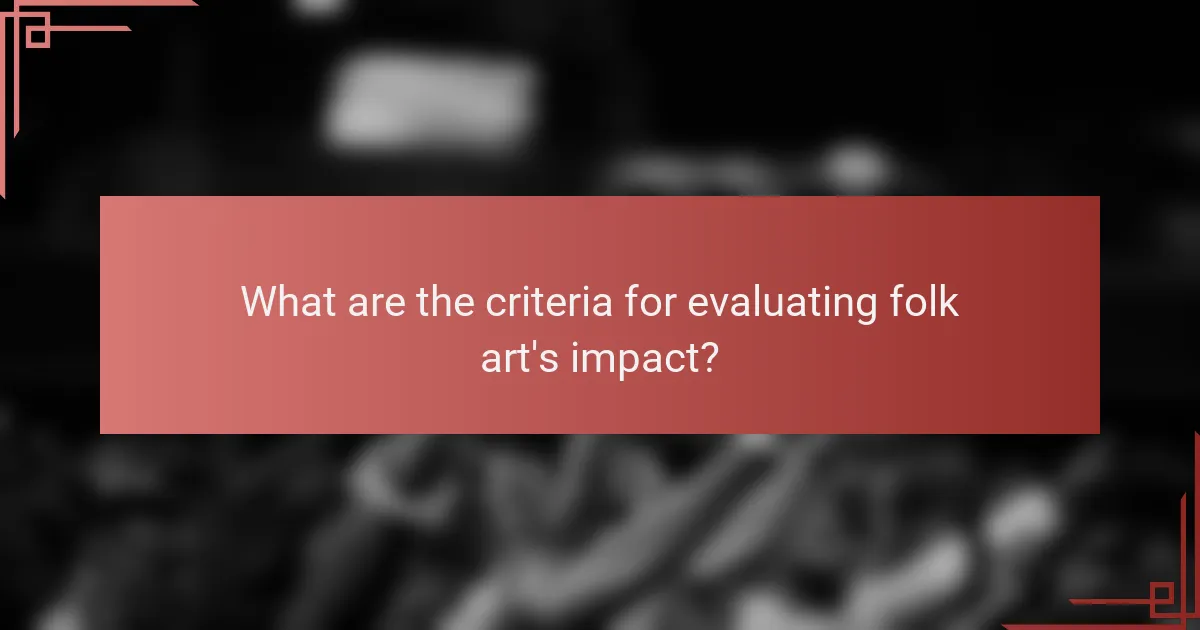
What are the criteria for evaluating folk art’s impact?
Evaluating the impact of folk art involves assessing its role in community engagement and cultural preservation. Key criteria include the extent of participation, the effectiveness of cultural transmission, and the art’s influence on social movements.
Measuring community engagement
Community engagement in folk art can be measured through participation rates in events, workshops, and collaborative projects. Surveys and interviews can provide insights into how individuals feel connected to their cultural heritage through these activities.
Consider tracking attendance numbers, demographic diversity, and the frequency of events. Engaging local schools and organizations can also enhance participation and foster a sense of ownership among community members.
Assessing cultural preservation
Assessing cultural preservation involves examining how folk art practices maintain or revive traditional techniques and narratives. This can be evaluated through documentation of artistic methods, the transmission of knowledge across generations, and the incorporation of historical themes in contemporary works.
Look for indicators such as the establishment of cultural centers, workshops focused on traditional crafts, and the presence of local festivals celebrating folk art. Collaborations with cultural institutions can further strengthen preservation efforts and raise awareness about the significance of these art forms.

How does folk art foster community engagement in rural areas?
Folk art fosters community engagement in rural areas by promoting cultural expression and collaboration among residents. Through shared artistic practices, individuals can connect over common heritage, enhancing social bonds and local identity.
Examples of rural folk art initiatives
Numerous rural communities have embraced folk art initiatives to strengthen ties among residents. For instance, community mural projects often involve local artists and residents working together to create large-scale artworks that reflect their shared history and values. Additionally, craft fairs and festivals showcase traditional crafts, allowing artisans to sell their work while engaging with the community.
Another example is the establishment of cooperative art studios where local artists can collaborate on projects, share skills, and host workshops for community members. These initiatives not only promote artistic expression but also provide opportunities for learning and cultural exchange.
Benefits of folk art in rural community building
Folk art significantly contributes to community building by fostering a sense of belonging and pride among residents. Engaging in artistic activities can help individuals feel more connected to their community, leading to increased participation in local events and initiatives.
Moreover, folk art can serve as a catalyst for economic development in rural areas. By attracting tourists to art events and exhibitions, communities can generate income and support local businesses. This economic boost can further enhance community resources, creating a positive feedback loop that encourages ongoing engagement and collaboration.
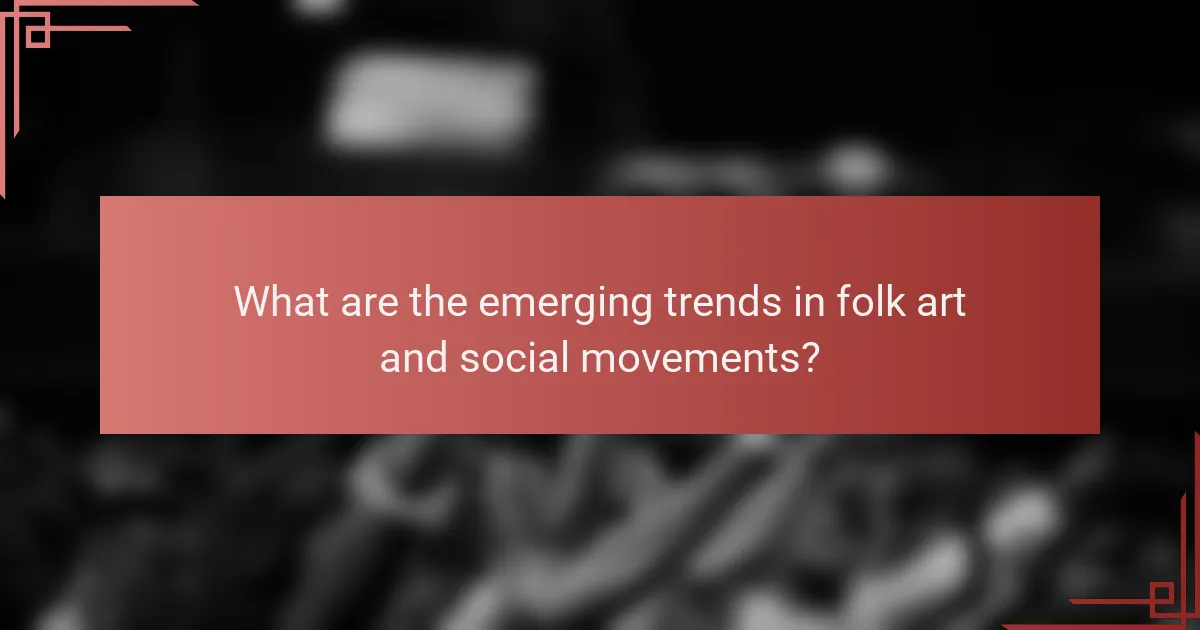
What are the emerging trends in folk art and social movements?
Emerging trends in folk art reflect a growing intersection with social movements, emphasizing cultural expression and community engagement. Artists are increasingly using their work to address social issues, promote inclusivity, and foster dialogue within their communities.
Digital platforms for folk art dissemination
Digital platforms have revolutionized the way folk art is shared and appreciated. Artists can now showcase their work on social media, online galleries, and dedicated art websites, reaching global audiences without geographical constraints.
These platforms allow for interactive engagement, enabling artists to connect with viewers and receive immediate feedback. This interaction can enhance the visibility of cultural narratives and social messages embedded in folk art.
Global influences on local folk art practices
Globalization has introduced diverse influences into local folk art practices, blending traditional techniques with contemporary themes. Artists often draw inspiration from international styles, creating unique hybrids that reflect both local heritage and global trends.
This cross-pollination can lead to a richer cultural tapestry, but it may also raise concerns about cultural appropriation. Artists must navigate these influences thoughtfully to honor their roots while embracing innovation.
Future of folk art in social activism
The future of folk art in social activism looks promising as artists increasingly leverage their work to advocate for change. Folk art can serve as a powerful medium for storytelling, raising awareness about social issues such as inequality, environmental concerns, and human rights.
As communities continue to engage with these themes, folk art will likely evolve into a more prominent tool for activism, fostering solidarity and inspiring action. Artists should consider collaborating with local organizations to amplify their impact and reach wider audiences.



